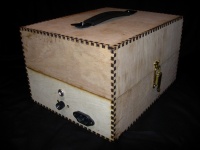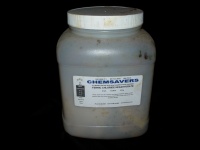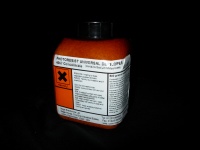Photoresist PCB Etching
Boards from vpcinc.com have been tested and work with the method described below
Procedure
[edit | edit source]Rub the developed board to remove the exposed portions of the plastic.
Equipment
[edit | edit source]UV Exposure Box
[edit | edit source]
Description
[edit | edit source]This wooden box contains eight ultraviolet UV-C germicidal lamps (type M6T5).
Health and Safety
[edit | edit source]UV-C light is dangerous! The radiation due to these lamps is harmful to the eyes and skin. You should not look at these lamps while they are on.
Usage
[edit | edit source]For this particular box the ideal exposure time is 4 minutes.
Product Information
[edit | edit source]Chemsavers Ferric Chloride Hexahydrate
[edit | edit source]
Description
[edit | edit source]CAS 10025-77-1
MF FeCl3.6H2O
MW 270.30
Features
[edit | edit source]97.4% Purified
Health and Safety
[edit | edit source]"Causes eye, skin, respiratory, and digestive tract burns. Maybe harmful swallowed. May cause central nervous system effects, cardiac disturbances, liver and kidney damage. For laboratory use only. Not for drug, household or human consumption.
Mixing and Usage
[edit | edit source]Mix 200 g of ferric chloride into each 1000 ml of hot water.
Place your exposed board into the developer solution for two minutes. Move the container back and forth to keep a regular flow of solution across the surface of the board. Photoresist_PCB_Etching_Testing
It seems to take approximately 15 minutes of immersion in the etchant solution. This figure was determined while agitation the solution. More time is likely necessary if the board was just sitting still in the solution. The solution was tested at room tempreature. A shorter immersion time would be likely if the solution were at a higher temperature.
Seno 4007 Developer Powder
[edit | edit source]
| Mega Part number | Mass | Yield Volume |
| 600-007 | 500 g | 10 liter |
| 600-008 | 50 g | 1 liter |
| 600-009 | 5 g | 0.5 liter |
Description
[edit | edit source]A powder for making liquid developer for the processing of Mega's Fotoboard, FPC-16 and other alkaline-developed positive photoresists. Supplied as a powder to make 0.5 to 10 liters of developer solution.
Features
[edit | edit source]4007 Seno developer is very stable and contains no "Caustic Soda" (sodium hydroxide NaOH). The developer has a high safety margin against over development. A board can be left immersed for up to 25 times longer than the normal, 30 seconds developing time without any risk of over developing or thinning a board's resist layer. The developer has a long life when used in a PCB processing tank, or when stored in an air-tight container.
Health and Safety
[edit | edit source]Full health and safety details. A report by an occupational hygienist concluded that, under the test conditions, NO LOCAL EXHAUST VENTILATION IS REQUIRED using this developer in Mega's PCB processing tanks. Copies of the report are available upon request from Mega Electronics Ltd..
Mixing and Usage
[edit | edit source]Fotoboard (1) and FPC 16 (1)
[edit | edit source]Mix 1 part developer with 9 parts cold tap water (500 ml with 4.5 ml to make 5 ml). WIth this mix and using our fotoboard image will appear in 20 to 30 seconds. Board should be fully developed in 1 to 2 minutes depending on temperature. Should be 18 to 24 degrees C. If not developing properly or takes a long time add 100 to 200 ml conc. to your working solution. Repeat as necessary.
Fotoboard (2) and FPC 16 (2)
[edit | edit source]If the above concentrations are used with Fotoboard (2) resist the image will develop within 15 seconds when it should be rinsed immediately. For greater safety margin against over-development, use at half strength (250 ml developer concentrate to makeliters of working solution) Please note that reducing developer strength may result in the solution having a shorter working life.